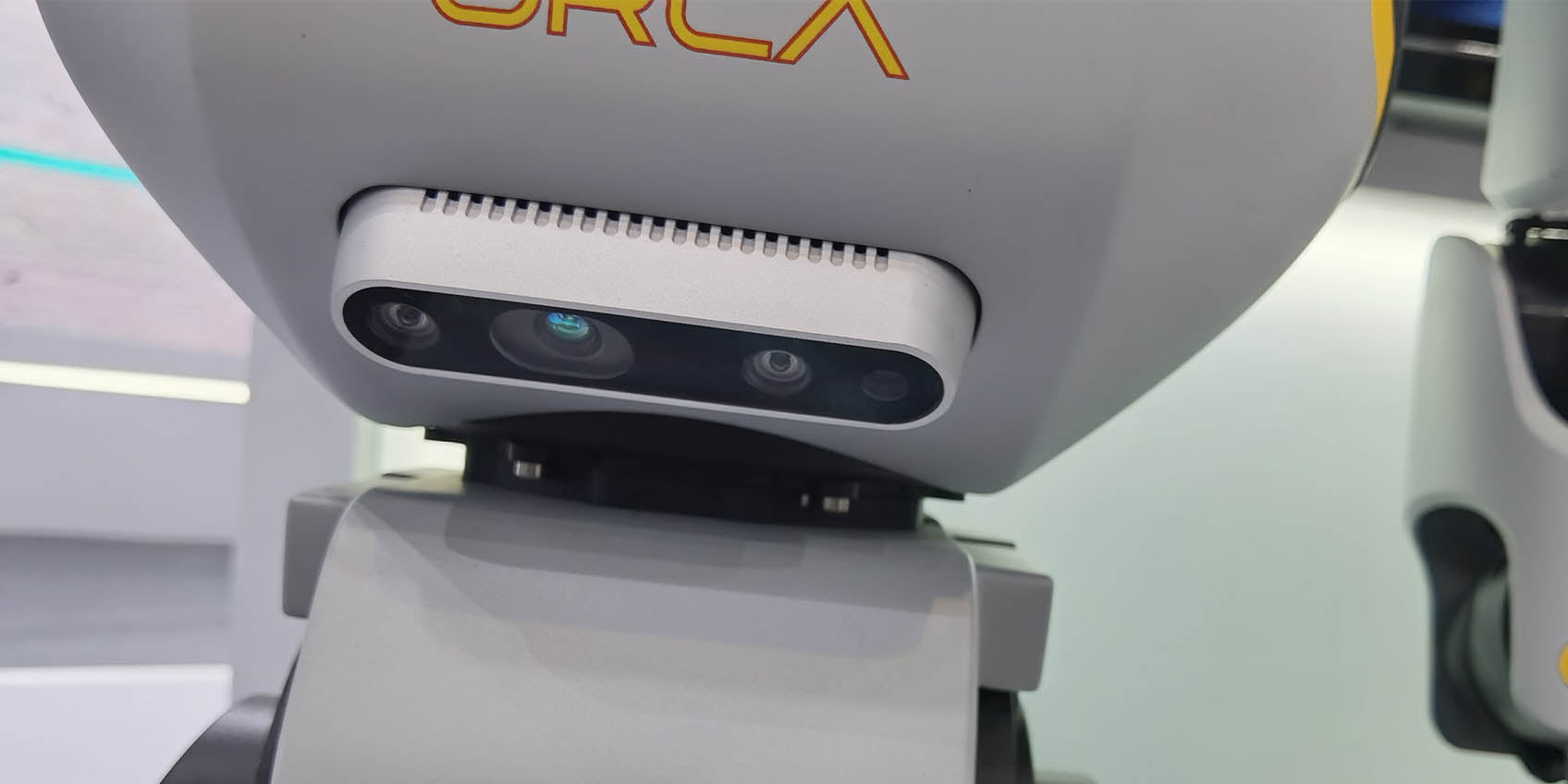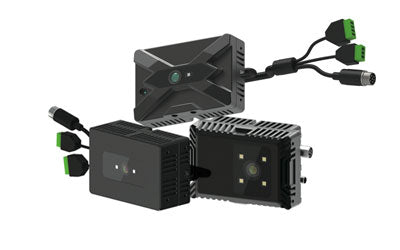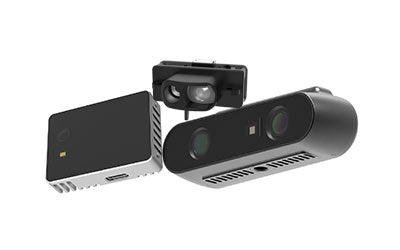KI-Roboter mit ToF-Sensoren: Die Zukunft intelligenter Interaktion und Erfahrung

Mit der rasanten Entwicklung der künstlichen Intelligenz (KI) und der Robotik wird der Einsatz von ToF -Sensoren (Time-of-Flight) in KI-Robotern auf Messen immer häufiger.
Als präzise Distanzsensortechnologie ermöglichen ToF-Sensoren Robotern die Erfassung räumlicher Tiefeninformationen in Echtzeit und ermöglichen so Innovationen in den Bereichen intelligente Dienste, interaktive Erlebnisse und Eventmanagement. Zukünftig werden KI-Roboter mit ToF-Sensoren noch innovativere Anwendungen präsentieren und Besuchern, Ausstellern und Veranstaltern beispiellose Smart-Service-Erlebnisse bieten.
So funktionieren ToF-Sensoren
ToF-Sensoren senden Lichtimpulse aus und messen die Zeit, die das Licht benötigt, um von Objekten reflektiert zu werden und zum Sensor zurückzukehren. Dadurch wird die Entfernung zwischen Objekt und Sensor berechnet. Mithilfe dieser Technologie können Roboter 3D-Tiefeninformationen in Echtzeit erfassen, Objekte und Personen in der Umgebung erkennen und sowohl Personen als auch Objekte präzise erfassen und zählen. Dies ermöglicht eine präzise räumliche Wahrnehmung bei Navigation, Interaktion und Datenerfassung auf Ausstellungen.
Zukünftige Anwendungen von KI-Robotern mit ToF-Sensoren auf Messen
-
Intelligente Navigation und autonome Führung
Messegelände sind oft überfüllt und unübersichtlich gestaltet, was es Besuchern erschwert, ihre gewünschten Stände oder Bereiche schnell zu finden. KI-Roboter mit ToF-Sensoren können das Gelände in Echtzeit scannen und eine 3D-Karte der Messe erstellen, um Besucher autonom zu navigieren und zu ihren gewünschten Ständen zu leiten.Diese Roboter können Hindernisse und Personen in der Umgebung erkennen und ihre Bewegungswege entsprechend anpassen, um eine sichere Fortbewegung zu gewährleisten. Zukünftig werden Ausstellungsroboter nicht nur Routenführung bieten, sondern auch Ausstellungsinhalte basierend auf den Interessen der Besucher empfehlen und personalisierte Rundgänge anbieten, um das Besuchererlebnis zu verbessern.
-
Crowd Management und interaktive Erlebnisse
Mit ToF-Sensoren ausgestattete KI-Roboter können die Besucherdichte und dynamische Veränderungen auf Messen in Echtzeit erkennen. Durch die Überwachung des Verkehrsflusses kann der Roboter Veranstalter dabei unterstützen, Menschenmengen zu lenken, Staus zu vermeiden und die Reihenfolge am Veranstaltungsort zu optimieren. Darüber hinaus können Roboter die Bewegungsmuster der Besucher verfolgen und so gezieltere Interaktionen und Dienstleistungen anbieten.Wenn ein Roboter beispielsweise eine hohe Besucherdichte an einem Stand erkennt, kann er virtuelle Displays, Videoeinführungen oder Warteschlangenmanagement anbieten und so die Wartezeiten verkürzen. Zukünftig werden Messeroboter über stärkere Interaktionsmöglichkeiten verfügen und Besucher durch Sprachgespräche, Handgesten und sogar die Anzeige von Augmented-Reality-Inhalten (AR) einbinden und so ein immersives Messeerlebnis schaffen.
-
Intelligente Ausstellungen und personalisierte Empfehlungen
ToF-Sensoren in Kombination mit KI-Algorithmen ermöglichen es Robotern, Verhaltensmuster von Besuchern zu erkennen, deren Interessen zu identifizieren und personalisierte Ausstellungsempfehlungen zu unterbreiten. Zukünftig werden Messeroboter ToF-Sensoren nutzen, um die Annäherung oder Verweildauer von Besuchern zu erfassen und automatisch relevante Ausstellungsinformationen oder Werbeangebote anzuzeigen.Wenn ein Besucher beispielsweise an einem Stand verweilt, kann der Roboter die Produktfunktionen vorstellen oder detaillierte Informationen bereitstellen. Gleichzeitig schlägt er mithilfe intelligenter Empfehlungsfunktionen weitere interessante Produkte oder Dienstleistungen vor. Diese personalisierten Empfehlungen steigern nicht nur die Besucherinteraktion, sondern helfen Ausstellern auch, die Produktpräsenz und die Konversionsraten zu steigern.
-
Interaktive Displays und virtuelle Führung
Mit ToF-Sensoren ausgestattete KI-Roboter ermöglichen interaktivere Ausstellungen. Durch die Echtzeiterfassung der Bewegungen und Positionen der Besucher können Roboter virtuelle Displayfunktionen aktivieren und so AR- oder holografische interaktive Erlebnisse erzeugen. Besucher können durch Handgesten oder Sprachbefehle mit dem Roboter interagieren, um detailliertere Informationen zu den Ausstellungsstücken zu erhalten.In zukünftigen Ausstellungen können Roboter auch als virtuelle Führer fungieren und Besucher durch virtuelle Rundgänge durch die Ausstellungsfläche führen. Besucher profitieren von der Echtzeit-Navigationshilfe des Roboters und erleben virtuelle Darstellungen entweder durch AR- Brillen oder den Bildschirm des Roboters immersiv. Dies steigert den technologischen und interaktiven Reiz von Ausstellungen erheblich.
-
Datenerfassung und intelligente Analyse
Die präzisen räumlichen Daten der ToF-Sensoren unterstützen Roboter nicht nur bei der Navigation und Interaktion auf Messen, sondern auch bei der Datenerfassung und -analyse. Roboter können Besucherverhalten und Verweildauer in Echtzeit überwachen. So können Veranstalter erkennen, welche Ausstellungsbereiche oder Produkte die größte Aufmerksamkeit erregen, und so zukünftige Messelayouts und Marketingstrategien optimieren.Künftig werden KI-Roboter mit ToF-Sensoren in Big Data- und KI-Analysesysteme integriert und erstellen während Ausstellungen automatisch detaillierte Berichte zu Besucherverhalten, Besucherverteilung, beliebten Exponaten und anderen wichtigen Daten. Dies ermöglicht Veranstaltern und Ausstellern eine wissenschaftlich fundierte Leistungsbewertung und Entscheidungsunterstützung.
Vorteile von KI-Robotern mit ToF-Sensoren in Ausstellungen
-
Präzises räumliches Bewusstsein und Echtzeitreaktion
ToF-Sensoren ermöglichen Robotern eine äußerst präzise räumliche Tiefenwahrnehmung und sorgen dafür, dass sie schnell auf Umgebungsveränderungen reagieren können. Diese präzise räumliche Wahrnehmung ermöglicht es Robotern, sich flexibel in überfüllten Ausstellungsumgebungen zu bewegen, Kollisionen zu vermeiden und eine sichere und reibungslose Interaktion mit Besuchern zu gewährleisten. -
Kontaktlose Bedienung und sichere Interaktion
Die berührungslose Messfunktion von ToF-Sensoren erhöht die Sicherheit von Robotern auf Messen. Roboter können die Nähe und Aktionen der Besucher berührungslos erfassen, wodurch Kollisionen vermieden und ein reibungsloses Messeerlebnis gewährleistet wird. Darüber hinaus verbessert der berührungslose Betrieb die Hygienestandards, da der direkte menschliche Kontakt während der Veranstaltungen reduziert wird. -
Rund-um-die-Uhr-Betrieb
ToF-Sensoren sind unabhängig von den Umgebungslichtbedingungen, sodass Roboter in jeder Lichtumgebung effizient arbeiten können. Messeroboter können in verschiedenen Ausstellungsbereichen und zu verschiedenen Zeiten kontinuierliche Dienste leisten, insbesondere in schwach beleuchteten Bereichen wie unterirdischen Bereichen oder bei Abendveranstaltungen, und so einen effektiven Service rund um die Uhr gewährleisten. -
Intelligente und personalisierte Dienste
Durch die Integration von KI-Technologie ermöglichen ToF-Sensoren Robotern, das Besucherverhalten zu erkennen und personalisierte Dienste anzubieten. Ob sie nun Exponate basierend auf Besucherinteressen empfehlen oder exklusive Führungen für VIP-Kunden anbieten – zukünftige Messeroboter analysieren Daten, um hochgradig personalisierte Erlebnisse zu bieten und so die Besucherzufriedenheit und die Ergebnisse der Aussteller zu steigern.
Zukünftige Entwicklung von KI-Robotern mit ToF-Sensoren in Ausstellungen
-
KI- und Multisensor-Integration für intelligente Upgrades
Zukünftige Ausstellungsroboter werden mehr Sensoren integrieren, beispielsweise visuelle Sensoren, Spracherkennung, Tiefenkameras und Temperatursensoren, um umfassendere intelligente Dienste anzubieten. KI-Technologie wird Daten mehrerer Sensoren analysieren, um die Entscheidungsfindung der Roboter weiter zu verbessern und so Interaktionserlebnisse und Serviceeffektivität zu optimieren. -
Multidimensionales Ausstellungserlebnis, das Virtualität und Realität vereint
Dank der 3D-Tiefenerkennung durch ToF-Sensoren bieten Ausstellungsroboter ein multidimensionales Erlebnis, das virtuelle und reale Elemente kombiniert. Zukünftige Roboter werden reichhaltigere interaktive Szenen in Virtual Reality (VR) und Augmented Reality (AR) generieren und so eine neue Form von Ausstellungen ermöglichen. Sie könnten sogar virtuelle Rundgänge für Besucher anbieten, die nicht persönlich anwesend sein können. -
Automatisiertes und kollaboratives intelligentes Ausstellungsmanagement
Zukünftige Ausstellungsroboter werden mithilfe von ToF-Sensoren mit anderen automatisierten Systemen (wie Sicherheits-, Reinigungs- und Lichtsteuerung) zusammenarbeiten und so ein intelligenteres Ausstellungsmanagement ermöglichen. Roboter werden nicht nur Besucherservices anbieten, sondern auch bei der Instandhaltung und Verwaltung des Veranstaltungsortes helfen und so einen effizienten und sicheren Ablauf von Ausstellungen gewährleisten.
Abschluss
KI-Roboter mit ToF-Sensoren , ToF-Kamerasensoren , Tiefenkameras und Distanzsensoren eröffnen grenzenlose Möglichkeiten für die intelligente Weiterentwicklung von Ausstellungen. Durch präzises Raumbewusstsein, intelligente Interaktion und Echtzeit-Navigation verbessern Ausstellungsroboter das Besuchererlebnis und bieten Veranstaltern und Ausstellern effizientere Tools zur Datenanalyse und -verwaltung. Mit der Weiterentwicklung der KI-Technologie und der Multisensor-Integration werden zukünftige Ausstellungen intelligenter. Roboter spielen eine immer wichtigere Rolle bei der Bereitstellung personalisierter und immersiver Erlebnisse und führen die Ausstellungsbranche in eine effizientere und intelligentere Zukunft.
Synexens 3D RGBD ToF Tiefensensor_CS30
Unser professionelles technisches Team, spezialisiert auf 3D-Kamera-Entfernungsmessung, steht Ihnen jederzeit zur Verfügung. Egal, ob Sie nach dem Kauf Probleme mit Ihrer TOF-Kamera haben oder Fragen zur TOF-Technologie haben, kontaktieren Sie uns jederzeit. Wir legen Wert auf hochwertigen technischen Kundendienst und ein optimales Benutzererlebnis, damit Sie unsere Produkte unbesorgt kaufen und nutzen können.
-
Veröffentlicht in
CS40






